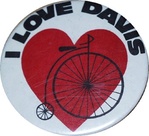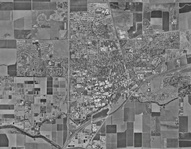Davis includes the City of Davis, the University of California, Davis (UCD), and the outskirts of Davis.
"Ten square miles surrounded by reality."
 I <3 Davis.
I <3 Davis.  Davis from the air. Courtesy of terraserver.microsoft.com.
Davis from the air. Courtesy of terraserver.microsoft.com.
The City of Davis is a medium sized city (2016 pop. about 68,000) (source: davis ca population) located in the southern part of the Sacramento Valley, in the northern part of California's Central Valley. It is about one hour northeast of the Bay Area on the north and south sides of the I-80 Freeway, about 15 minutes before Sacramento. More precisely, its location is 38.554643 latitude and -121.745001 longitude. It is about 50 f. (16 m.) above median sea level and enjoys a Mediterranean climate with hot, dry summers and mild, rainy winters.
The University of California, Davis (UC Davis) is mainly why Davis is famous. It is one of the best research and teaching universities in the world, and an institution that swells the city population by approximately 20,000 nine months of the year. The city within a city has the largest area of any campus of the University of California. Because of the major presence of the university, Davis, demographically, is a very young city, with half of inhabitants being under 25 years of age
Davis has been lauded as the most educated city in California. Because of its progressive politics, it has been called The People's Republic of Davis. Considering themselves so well-educated, Davisites are also very outspoken and rarely does anything happen without the local population weighing in... even college students want a say in how the city is governed. Davis has recently been rated by CNN Money Magazine as the second most educated city in the US (in terms of percentage of residents with college degrees), after Arlington, VA. And in 2009, Davis was ranked 19th on Forbes Magazines' list of "America's Top 25 Towns to Live Well."
Also well-known as "Bike Capital" of the United States, Davis won the moniker Bike City, USA as it has more bicycle ridership and ownership per capita than anywhere else in the nation. The city embraces this reputation and scores of professional and amateur bicyclists call Davis home. With tons of bike circles, bike lights, bike paths, and sometimes even bike sculptures, the town is very nice for bicycling. Davis is also home to a great deal of other things and implemented the nation's first energy conservation building code. We invite you to skim through our town history to get a glimpse of how we got to this place. Outside Magazine recently called Davis one of the best towns in the U.S. and the California State Auto Association reviewed the town in the Jan 2006 issue of Via Magazine.
Davis is home to a wide variety of activities both through the university and the city itself. Picnic Day is a great opportunity to see many of these events showcased, such as various water sports, fencing, horse polo, and numerous "green" activities.
Although preceded by farmland, Davis (or at the time, Davisville), was created in 1868 by the Davisville Land Company as a railroad town, eventually becoming a California municipality in 1917.
Davis can be divided into several areas: Downtown, North Davis, South Davis, East Davis, West Davis, Central Davis, and the surrounding land.
If you're new to Davis then the wiki is a great place to find out what's here. You might also check out the Davis Conference & Visitor's Bureau. If you're visiting Davis for the first time, you may want help navigating Davis and a local map. To get a pretty good feel for why some of us live here beyond the time required to graduate, check out why I Love Davis.
For an overview of Davis culture, see this item from the primary local newspaper: http://www.davisenterprise.com/special-editions/from-acme-theatre-to-zipcar-we-explain-it-all-2/



